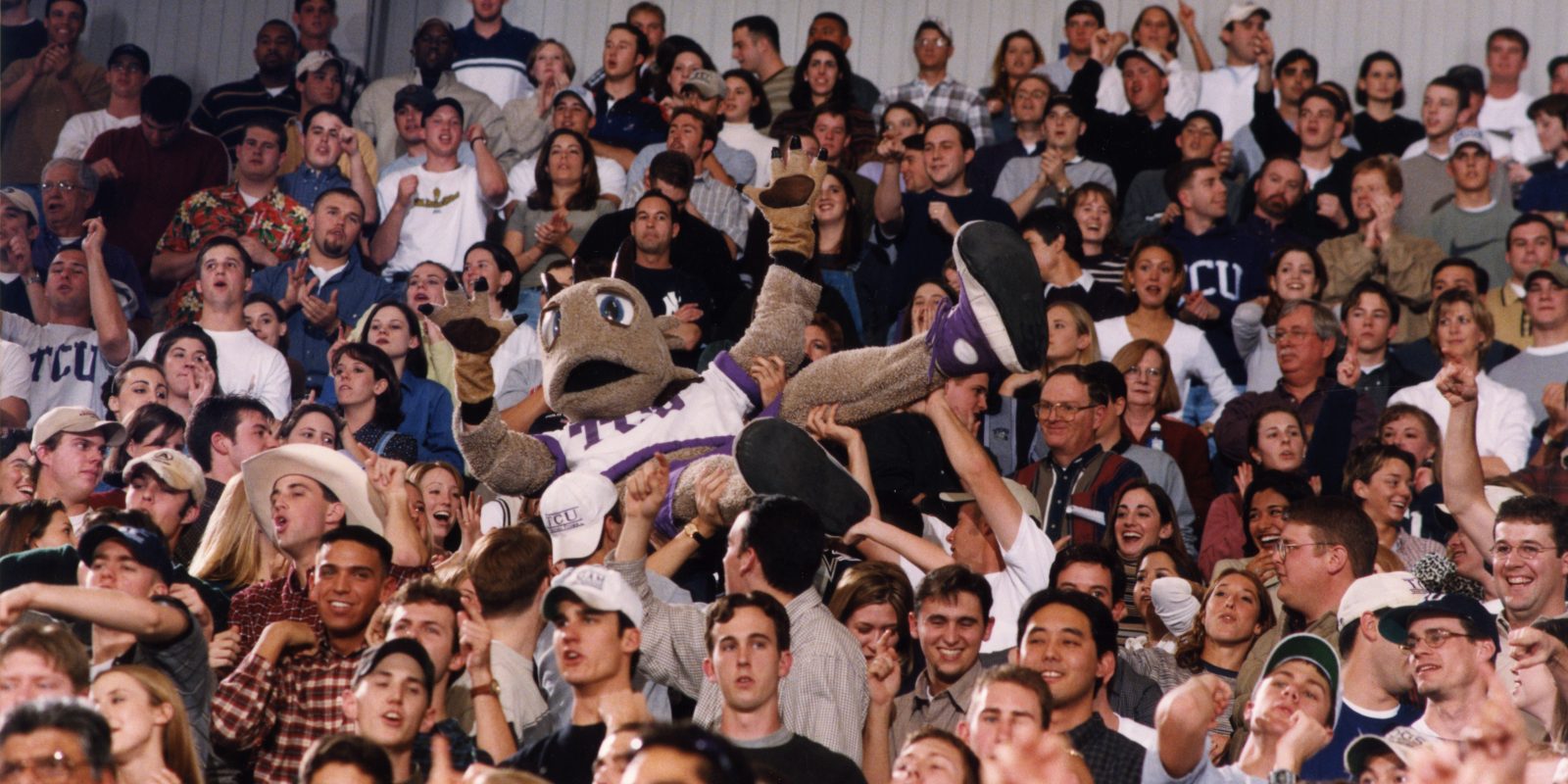
It’s a boy. It’s a dog. It’s SuperFrog!
Over the course of a century, the TCU mascot has varied in design and species.
Rampant superstitions may be the reason teams started the tradition of mascots. From the French word mascotte, with roots meaning witch, wizard or sorcerer, a mascot is a talisman or source of good luck.
TCU’s Horned Frog ties go back to 1897, when the yearbook and the football team adopted the name of the once-plentiful Texas lizard. But TCU mascots, the living embodiments, have varied in design and even species for nearly a century.
In 1921, the mascot of the Horned Frog football squad was a young boy. The tradition of having a boy on the team continued through the 1960s, although TCU added a costumed mascot in 1949. Victor “Little Vic” McDonald, the 7-year-old son of the athletic director’s secretary, held the jersey number ½ on the Frog football team in 1954 and 1955.
The baseball team, in the early 1920s, had a dog with a purple body and white head for a mascot. On May 17, 1924, the dog was found dead. The cause? Poison. The Skiff called for a remorse of conscience for the dog’s killers and their unsportsmanlike deed. The newspaper never identified a suspect.
A small black dog named Blackie became the unofficial mascot of TCU football after showing up and watching practice nearly every day in the fall of 1941. In 1930, the TCU band received a goat named Samuel, in honor of band director Claude Sammis. The goat was a gift from an exhibitor at the Southwestern Exposition and Fat Stock Show impressed by the band’s performance at the stock show the week before.
Suiting Up
Yale adopted the nation’s first university mascot, an English bulldog called Handsome Dan, in 1890. Many universities across the U.S. followed suit with other animals, and today sports fans know North Carolina’s ram with blue antlers and Louisiana State’s tiger, housed in a $3 million habitat.
Then there’s costumed mascots ranging from Ragin’ Cajuns’ Cayenne, an anthropomorphic pepper from the University of Louisiana at Lafayette, to Northern Kentucky University’s Norse named Victor E. Viking.
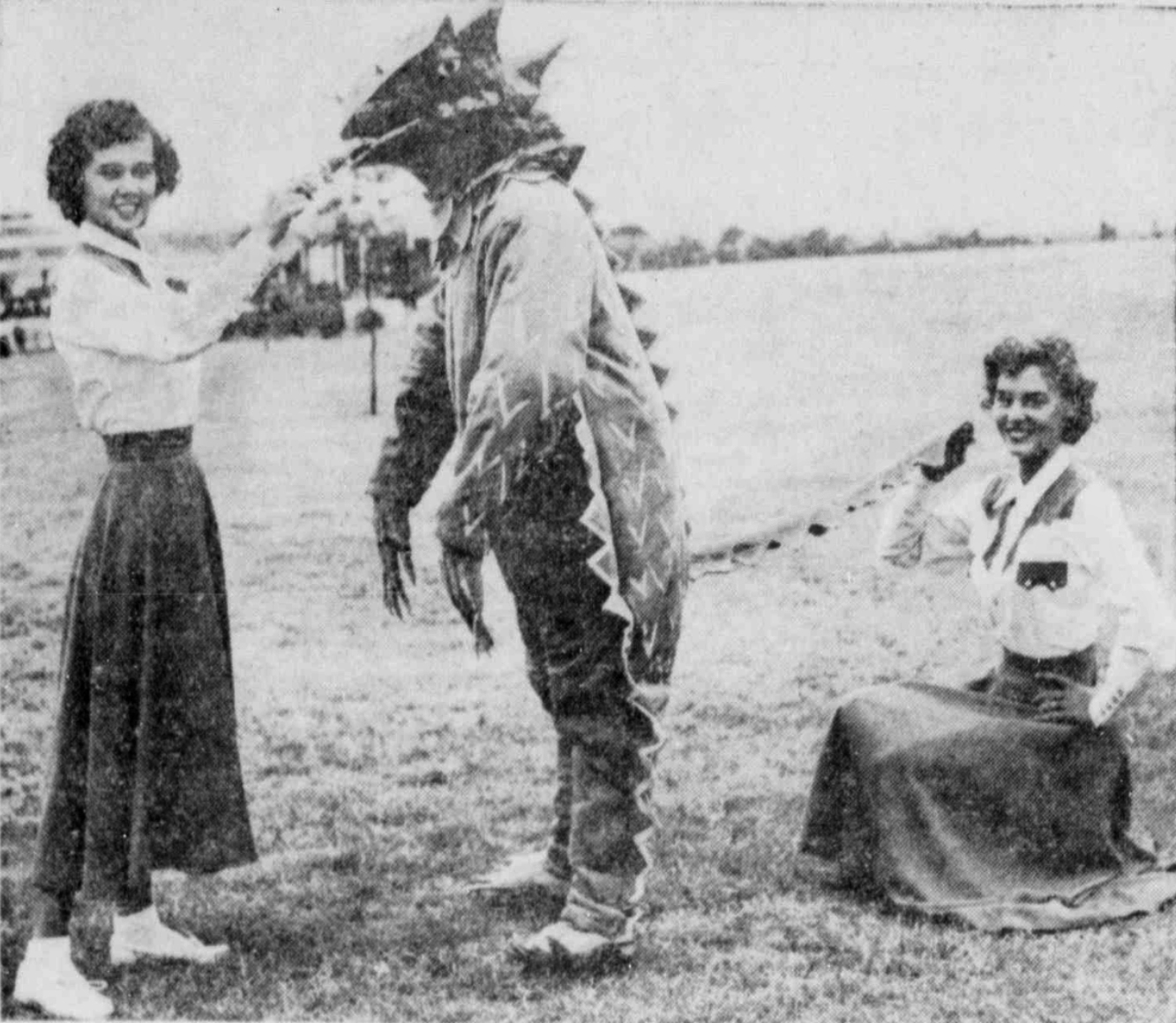
The first costume was purple and gray, with a papier-mâché head coated and lined with plastic. The body was fabric. The 6-foot Horned Frog debuted at the Sept. 24, 1949, home football game against Oklahoma A&M (now Oklahoma State). The game ended in a tie, 33-33. TCU Archives photo
In August 1949, TCU’s student government funded a $50 costume after repeated requests for a mascot that could participate in football halftimes and other campus functions.
“Every other school in the conference has some sort of mascot,” Jimmy Paschal ’50 told The Skiff. “And, while horned frogs as such are fairly plentiful, we’d look somewhat silly dragging one around on a string.”
The purple and gray costume consisted of a papier-mâché head, coated and lined in plastic, and a fabric body. Paschal served as the first mascot. The temporarily nameless 6-foot Horned Frog made his first public appearance at the Sept. 24, 1949, home football game against Oklahoma A&M (now Oklahoma State). The game ended in a 33-33 tie.
What’s in a Name?
Options for names were so plentiful that the pep cabinet couldn’t pick one, so it sponsored a contest. Students could also propose a name on an entry slip in The Skiff. “Suggested names should be short, easy to pronounce and a name that everyone in the nation would associate with a frog,” the article advised. And, “Oh yes, Jimmy Paschal, Amarillo senior, will be the breathing part of the mascot. This may or may not help in your selection of a name.”

In the early 1960s, the spelling of the mascot name flip-flopped between “Addy,” long the tradition, and “Addie” until a new costume and Ben-Hur-like chariot debuted in 1967. The Frogmobile was inscribed with “Addie The Fightin’ Frog.” TCU Archives photo
Three options accompanied The Skiff article: Tex, Addy and Hormone. Although students could suggest other names, a winning title emerged: Addy the All-American Frog, in honor of Addison Clark Jr., whose efforts brought football to TCU in 1896 and who was instrumental in giving the school its Horned Frog nickname.
In the early 1960s, the spelling of the mascot’s name flip-flopped between “Addy,” long the tradition, and “Addie” until a new costume was revealed along with the Frogmobile, which was inscribed with “Addie The Fightin’ Frog.” The Ben-Hur-like chariot debuted at the Oct. 21, 1967, Texas A&M football game, which the Frogs lost 0-20 at home. “Addie” stuck for the following 12 years.
Frog Togs
In over a half-century since the mascot’s birth, the costume has been replaced numerous times. Early costumes didn’t last long.
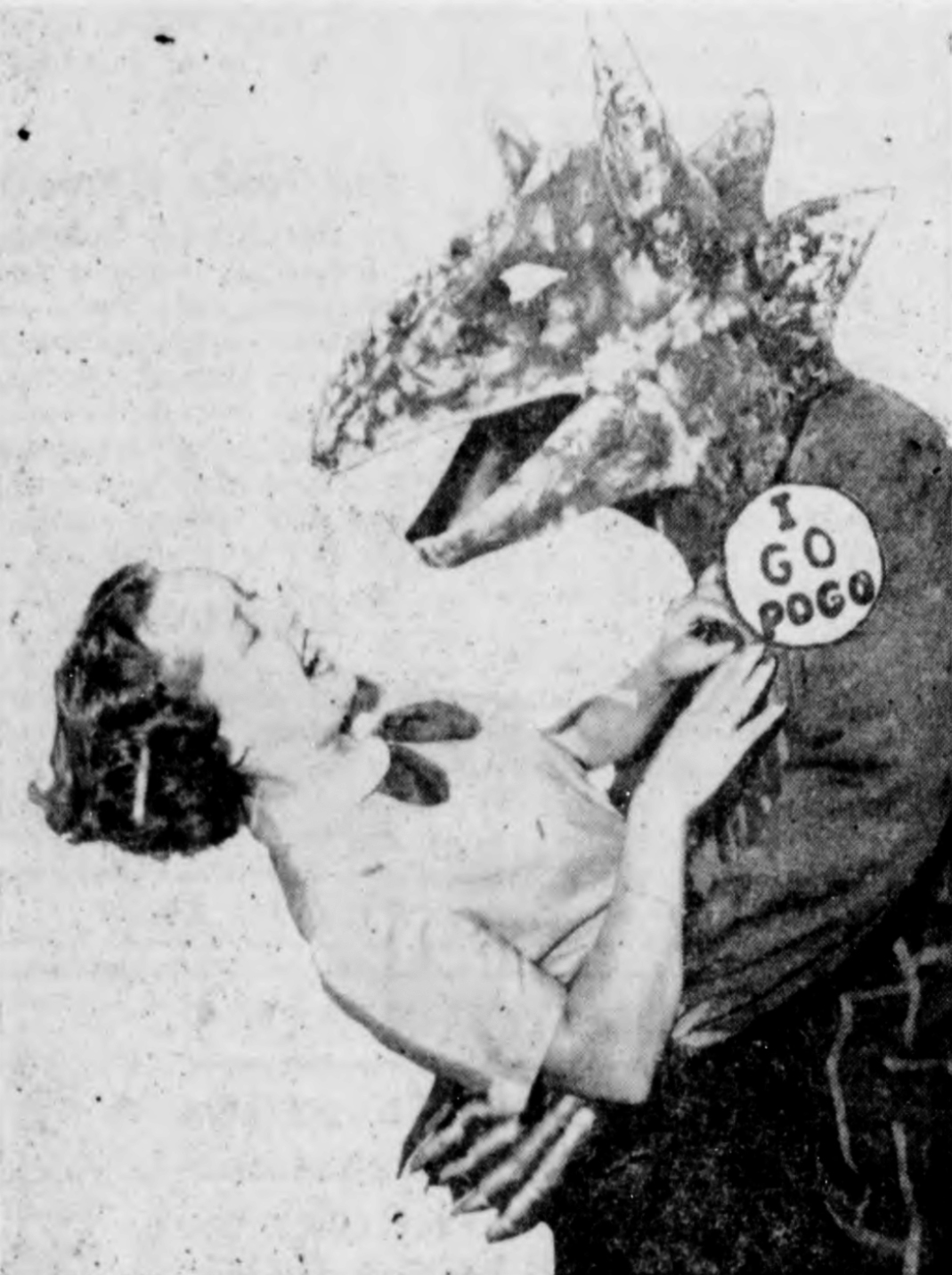
In a play off the 1952 U.S. presidential campaign, “I Like Ike,” Addy sported an “I Go Pogo” button for the visit of cartoon artist Walt Kelly. Some students suggested Addy as the comic strip possum’s running mate. Dwight “Ike” Eisenhower won that election. TCU Archives photo
Addy received a new costume (plus a letter jacket for the student inside) in 1952, costing the student congress $26.47. The fresh frog made his debut at the Oct. 4 game against Arkansas. Later that month, Addy sported an “I Go Pogo” U.S. presidential campaign button, and TCU supporters of Pogo, the comic strip possum, considered a possible “Addy for Veep” push. Dwight Eisenhower won the election.
On Feb. 27, 1979, the student government approved funding for a new mascot. The arrival of the costume warranted a new name, and John Grace, then director of sports promotion, deemed the creation Super Frog, later stylized to SuperFrog.
Grace’s iteration, including one nearly identical replacement in 1989, would serve TCU for 20 years.
Gorland Mar, then a graphic designer in the university’s marketing and communication department, decided the mascot needed a refresh.
“There became a need for photos with SuperFrog, and the old one wasn’t photogenic,” said Mar, now director of graphic design in marketing and communication at TCU. “We’d see these Linda Kaye black-and-white photos, and he just did not look appealing.” Linda Kaye ’63 specialized in sports photography.
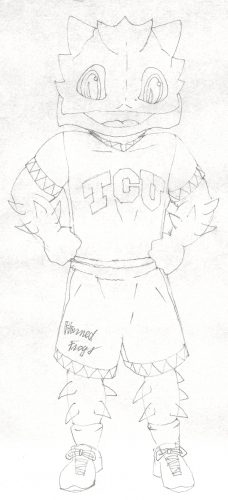
Gorland Mar’s SuperFrog sketch.
Mar looked to Sugars, a Canadian company, to build a new costume in 1999. “They had a good reputation. I remember seeing their examples and thinking they had quality mascots. They were very capable.”
Mar sketched a new SuperFrog from different angles, approved prototypes and even ordered an ice vest to keep the performer inside cool. The mascot traveled more than 1,400 miles to its home at TCU. But there was one problem. “It was too green, and people were worried it was too froggy,” Mar said. “I airbrushed him and grayed him up.”
Since Mar’s iteration, SuperFrog has gone through two more updates: a short-lived one with a grimacing head and the current muscular mascot with human-size tennis shoes and gloves.
“I knew they were evolving it, and I thought it was natural to do so,” Mar said. “It seemed like a natural evolution. You can kind of tell there’s DNA there. I thought they were improving it and making it more functional.”
What’s Inside Counts
For over three decades as the school year ended, one student was chosen to take over as the mascot. The student body elected the person in the ’50s and ’60s.
In the 1960s, student candidates, including those for Addy, wrote published essays explaining how they were right for the position. Cheerleaders started electing a student for Addy in 1963. The next year, student government chose candidates. For the 1966 spring election, the student government congress decided that the student body would elect the next mascot after candidates passed the cheerleaders’ screening committee.
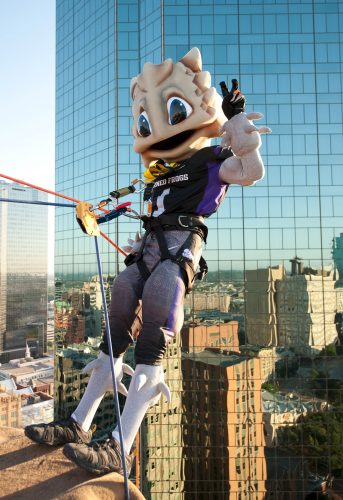
SuperFrog rappelled down the side of the 26-story XTO building in downtown Fort Worth, Texas, in July 2011 for a fundraising event benefiting Downtown Fort Worth Inc. TCU Archives photo
Disdain for the election process grew in the 1970s and revisions were made. Instead of an unlimited number of candidates vying for student body votes, cheerleader and Addy candidates were first selected by a panel.
The joint administration, faculty and student committee shifted to a board of National Cheerleaders Association members, and tryouts became public. In 1972, cheerleaders tried to pass a bill that would allow them to choose who would fill Addy’s role, but it failed. The following year, Addy candidates were limited to two students.
From driving a pumpkin homecoming float pulled by bears to occupying a mock jail cell for a fundraiser, the TCU mascot has widened its duties. At first one person held the role of mascot. As the creature grew more popular, so did its human crew. Today, up to six students share the responsibility of performing as the Horned Frog.
Sources: TCU Archives; The Skiff 1921 to 1989; todayifoundout.com; History of Texas Christian University: A College of the Cattle Frontier by Colby D. Hall, 1947; 1986 Horned Frog yearbook
Your Turn:
What’s your favorite mascot memory?
Email us your response (and photos if you have any): tcumagazine@tcu.edu

Your comments are welcome
Comments
Related reading:
Campus News: Alma Matters
Object Lesson: Fear the Frog Banner
A spectacular wave of revelry.
Features
Hhwaaaaaaaaaah! The Frog Horn!
What weights 3,000 pounds, blows smoke and instantly demands everyone’s attention? The huffing, puffing, hooting, tooting Frog Horn.
Sports: Riff Ram
First Person with… Kenrich Williams
From wounded to winner, the NIT standout is ready to succeed in his senior season with TCU men’s basketball.